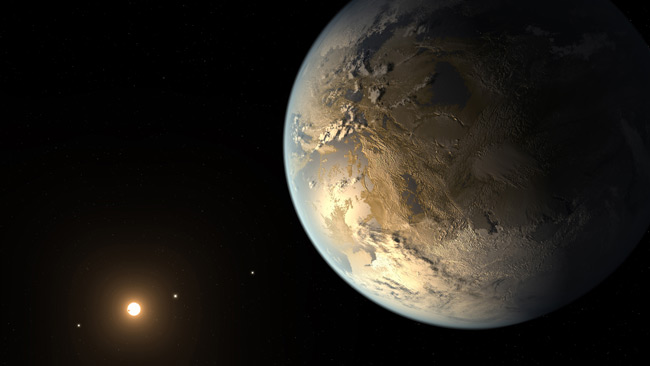First Earth-sized planet found in ’habitable zone’: NASA
Mangalore Today News Network
Washington, Apr 18, 2014: The hunt for potential life in outer space has taken a step forward an international team of researchers has discovered the first Earth-sized planet within the "habitable zone" of another star. The exoplanet dubbed Kepler-186f was first spotted by scientists using NASA’s Kepler telescope, according to research published today in the US journal Science.
The exoplanet dubbed Kepler-186f was first spotted by scientists using NASA’s Kepler telescope, according to research published today in the US journal Science.
The exoplanet, located some 500 light years from Earth, orbits in what is seen as the sweet spot around its star: not too close and not too far, so it could have liquid water, considered a crucial component to possibly hosting life.
"The discovery of Kepler-186f is a significant step toward finding worlds like our planet Earth," said Paul Hertz, NASA’s Astrophysics Division director at the agency’s headquarters in Washington.
"What makes this finding particularly compelling is that this Earth-sized planet, one of five orbiting this star, which is cooler than the Sun, resides in a temperate region where water could exist in liquid form," said Elisa Quintana of the SETI Institute at NASA’s Ames Research Center in California, the lead author of the paper published in Science.
Kepler-186f is around 1.1-times the size of Earth -- which researchers say is key to predicting the composition of the surface and its atmosphere.
When planets are 1.5 times the size of Earth or larger, many of them seem to attract a thick hydrogen and helium layer that makes them start to resemble gas giants like Jupiter or Saturn.
Kepler-186f is the fifth and outermost planet orbiting the Kepler-186 star, right on the far edge of that solar system’s habitable zone, meaning the surface temperature might not be warm enough to stop water from freezing.
"However, it is also slightly larger than the Earth, and so the hope would be that this would result in a thicker atmosphere that would provide extra insulation," explained San Francisco State University astronomer Stephen Kane, another member of the team behind the discovery.
Scientists using the NASA’s Kepler telescope first discovered it by tracking "transits" -- shadows that cross in front of the star.
The finding was confirmed by observations from the W M Keck and Gemini Observatories.
"The discovery of planets with Earth-like properties is one important link in the chain required to answer" whether life can exist on other planets, said co-author Fred Adams, an astronomer at the University of Michigan.
"And the discovery of the planet Kepler-186f is an important step toward finding a planet that is like our Earth," he added.
- Belthangady: 3 critical in collision between 2 cars
- Santhekatte road mishap: Critically injured hotel manager succumbs
- 4 injured as car overturns at Katapady
- Justice K S Hegde Institute of Management: Crafting global business minds for a changing world
- Uppinangady: House burgled when family visits church
- Uppinangady: Auto driver dies in collision with car
- Kasargod: Labourer stabbed to death
- Vijay Bharath Reddy takes charge as new SP of Kasargod
- India announces three-day mourning on passing of Pope Francis
- Diocese of Mangalore mourns the passing of his holiness Pope Francis
- Pope Francis passes away at 88 on Easter Monday
- City Corporation launch greening initiative ‘Amara’ in Mangaluru
- JEE Mains: Six Expert PU College Students Score 100 Percentile in Individual Subjects
- Twist in Bengaluru road rage: DRDO pilot, who played victim, booked for attempt to murder
- ISSF World Cup: India finish third in Peru World Cup
- Pope died of a stroke and heart failure, Vatican doctor says
- ‘There can be no peace without freedom of religion’- Pope Francis
- Janivara row: Govt will take action, says CM Siddaramaiah
- US Vice President JD Vance meets PM Modi, talks focus on trade deal
- In USA, Rahul Gandhi says poll body ’compromised’ in India; BJP hit back
- How Karnataka former DGP’s property fight with wife ended in Murder
- Opposition Slams BJP MPs’ Criticism of Supreme Court; BJP Distances Itself
- Honour to speak with PM Modi, will visit India later this year: Elon Musk
- India tears into Yunus regime over Hindu leader’s killing in Bangladesh
- Two homeguards suspended for asking students to remove sacred thread at Shivamogga college
- Skills and Competencies Take Center Stage at MSN Dialogue Series
- Court remands Maoist Lakshmi to six-day police custody
- Sandhya Shenoy honored with Society for Materials Chemistry Medal-2024
- White Cornus Apartment in Mangaluru
- City girl wins first place in state-level spell bee competition
- Alleged ‘Love Jihad’ Case in Mangaluru: Woman left home voluntarily, says police
- Girl fatally struck by reckless two-wheeler near Belman
- New residential complex for the judges inaugurated in Mangaluru
- Absconding accused nabbed after 8 years
- Truck with cylinders turns turtle in Beltangady
- Bhoota Kola artist dies of cardiac arrest
- Development of the country should be our goal: Ganesh Karnik
- Container truck gets stuck under Modankap railway bridge
- Truck crushes bike’s pillion rider near BC Road
- Head constable dies of heart attack
- CITY INFORMATION
- TRAVEL
- TOURIST INFORMATION
- HEALTH CARE
- MISCELLANEOUS




 Write Comment
Write Comment E-Mail To a Friend
E-Mail To a Friend Facebook
Facebook Twitter
Twitter  Print
Print 


